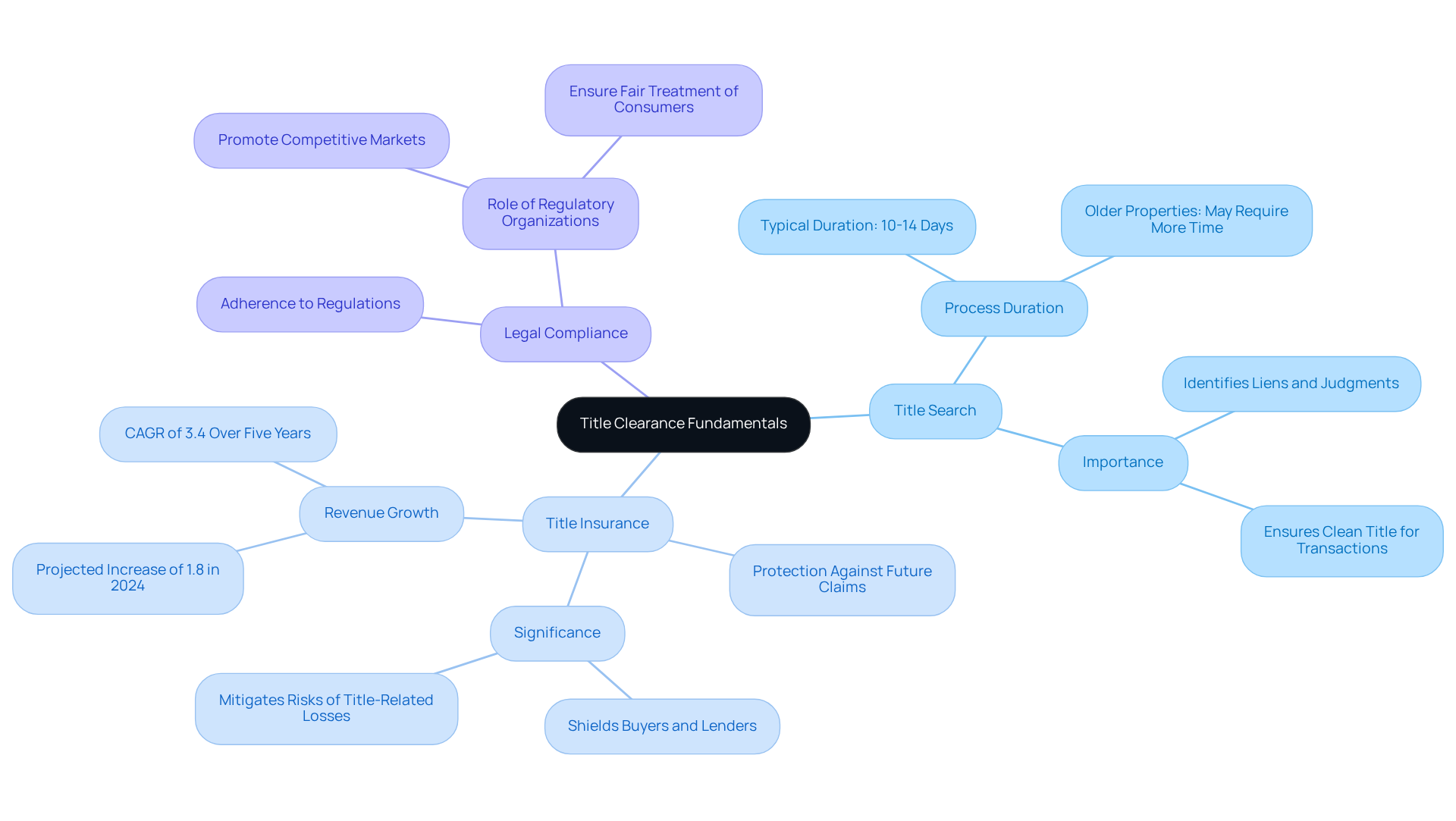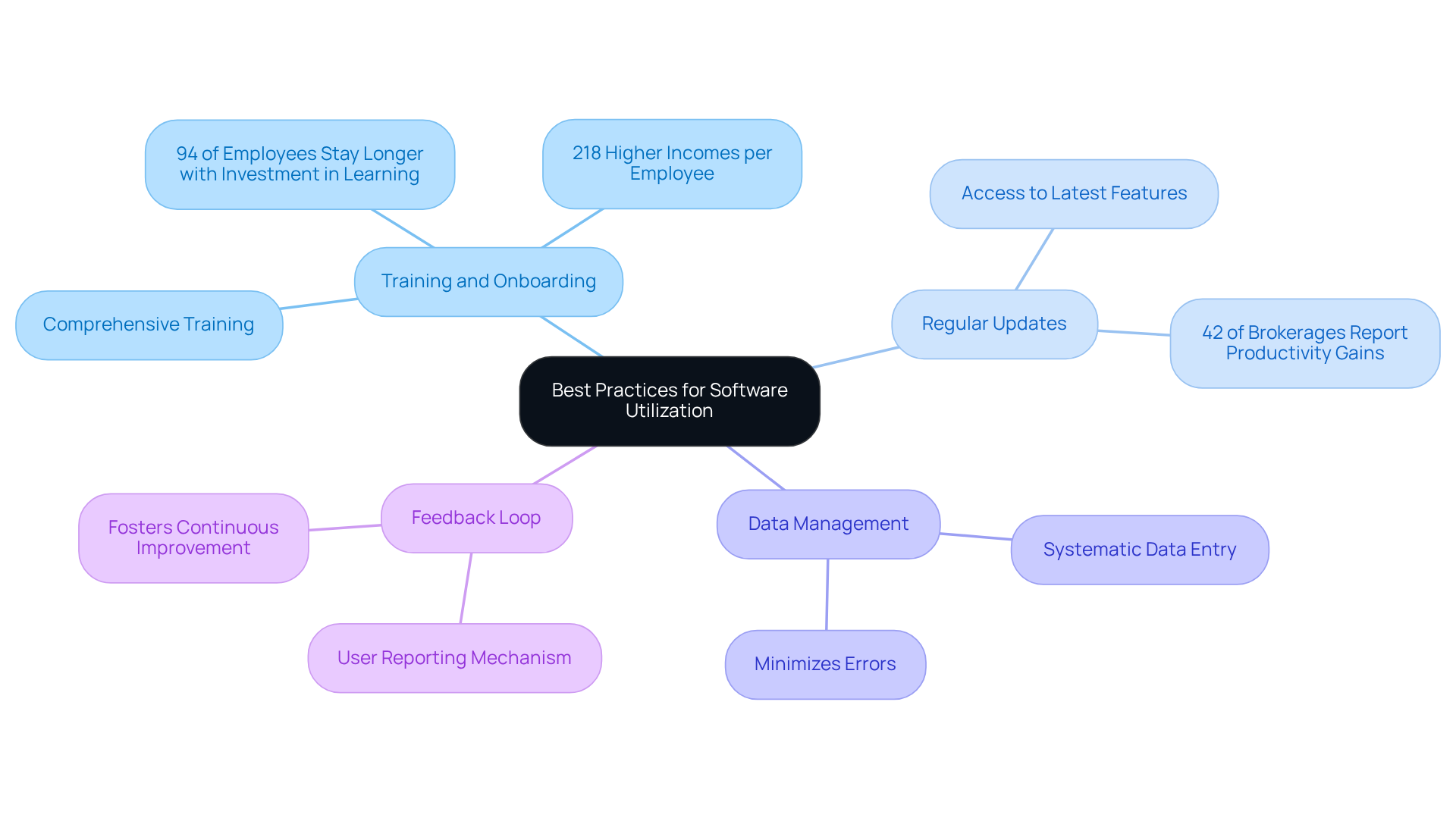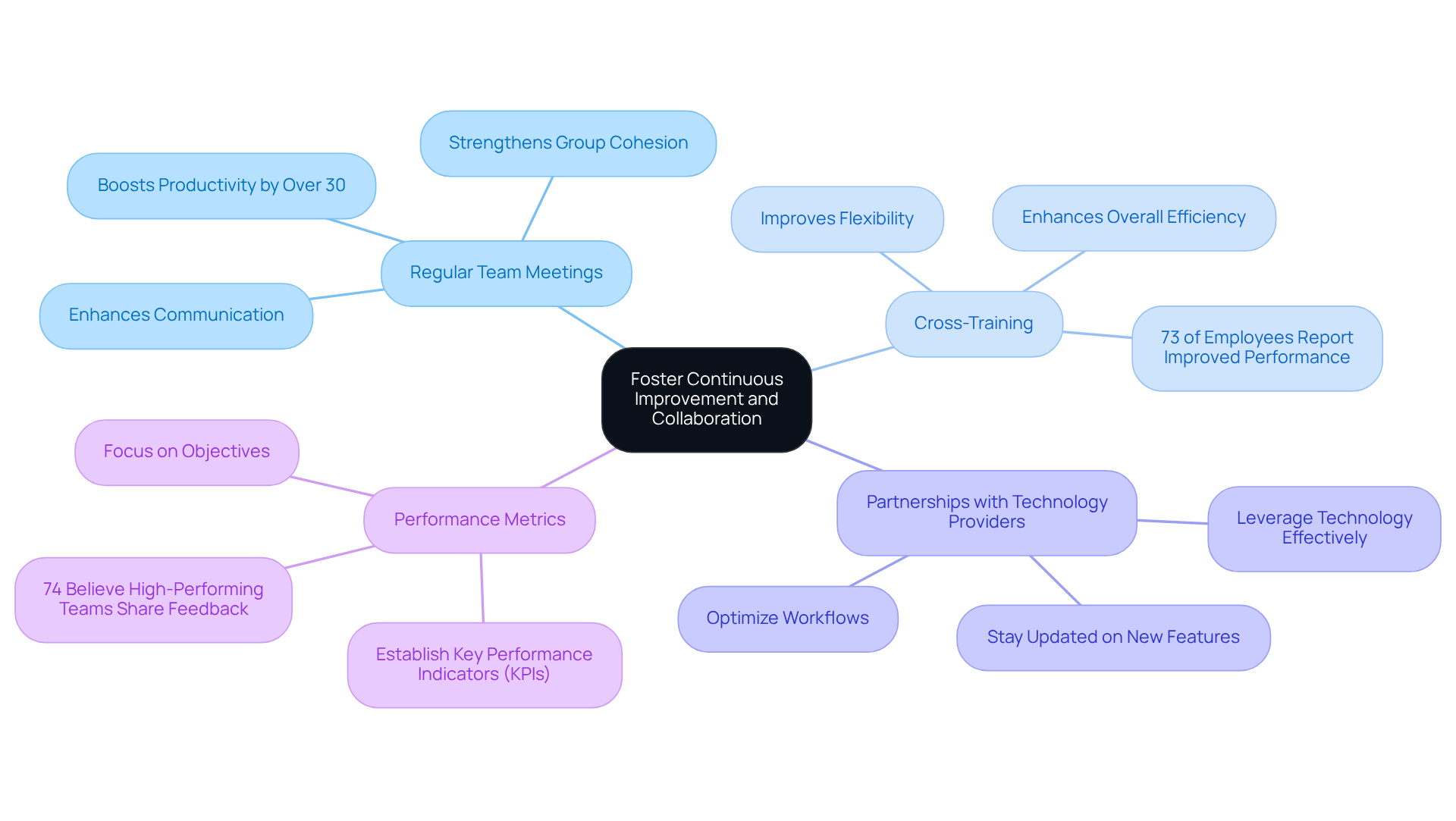Overview
The article emphasizes the critical role of four software solutions in enhancing title clearance rates for real estate professionals by streamlining processes and improving efficiency. It details how each software—Qualia, RamQuest, SoftPro, and Parse AI—provides specific functionalities that effectively address common challenges in title research. Consequently, these solutions lead to faster processing times and a reduction in errors during property transactions, reinforcing the necessity for accurate title research in the industry.
Introduction
Navigating the complexities of title clearance is essential for real estate professionals, as it ensures legal ownership and safeguards against potential disputes. With the right strategies and tools, the process can be streamlined, enhancing efficiency and minimizing risks. However, many in the industry struggle with outdated methods and digital inefficiencies that impede their success. What if leveraging advanced software solutions could revolutionize title research, resulting in higher clearance rates and improved transaction outcomes?
Understand Title Clearance Fundamentals
Title clearance is essential for verifying legal ownership and rights associated with a property. This process entails a careful review of names and documents to guarantee there are no issues, such as liens or disputes, that could threaten ownership. Key components of title clearance include:
- Title Search: A comprehensive review of public records to uncover any claims against the property. Title searches typically take between 10 and 14 days to complete; however, older properties may require additional time. This step is crucial, as it identifies any outstanding liens or judgments that could affect the transaction.
- Title Insurance: This safeguard protects against potential future claims that may arise after the purchase, covering defects such as adverse ownership claims and liens. As Demetrios Berdousis noted, "Title insurance shields buyers and lenders from title-related losses," highlighting its critical role in mitigating risks. Given the sector's anticipated revenue increase of 1.8% in 2024, the significance of insurance for property cannot be overstated.
- Legal Compliance: Ensuring that all documentation adheres to local and state regulations is vital for a smooth transaction. Regulatory organizations play a key role in promoting competitive markets and ensuring fair treatment of insurance consumers, which is essential for maintaining industry integrity.
Understanding these fundamentals equips real estate professionals to navigate the complexities of property ownership effectively, particularly through the use of software for improving title clearance rates, ensuring that transactions proceed without legal hindrances. Effective case studies, such as Parse AI's advancement in research, illustrate how utilizing software for improving title clearance rates can simplify these methods and enhance precision. For example, Parse AI's platform allows researchers to finish abstracts and reports more swiftly and precisely, leading to substantial cost savings and enhanced efficiency for real estate professionals. Furthermore, it is crucial to be mindful of frequent traps in the clearance procedure, such as the difficulties of performing a search alone, which can be time-consuming and complicated.

Leverage Advanced Software Solutions for Title Research
To enhance property clearance rates, real estate professionals must utilize software for improving title clearance rates that streamline processes and improve efficiency. The significance of accurate title research cannot be overstated, as it directly impacts organizational performance. However, challenges such as digital inefficiencies often hinder progress. Thus, the adoption of the following recommended tools is essential:
- Qualia: This comprehensive title and escrow platform enhances communication and streamlines workflows, facilitating faster processing of title orders. Recent updates have further enhanced its functionality, making it a preferred option among researchers of publications.
- RamQuest: Recognized for its strong production capabilities, RamQuest allows users to handle various transactions effectively, ensuring that all elements of processing are managed smoothly.
- SoftPro: With an intuitive interface, SoftPro streamlines management of ownership documents and escrow, ensuring compliance and greatly minimizing the risk of mistakes.
- Parse AI: By utilizing machine learning and optical character recognition, Parse AI rapidly extracts essential information from document titles, allowing researchers to complete abstracts and reports more quickly and accurately. This innovation not only enhances efficiency but also provides substantial cost reductions compared to conventional methods of examining titles.
Incorporating software for improving title clearance rates enables researchers to automate routine tasks, swiftly access extensive databases, and uphold precise, current documentation, ultimately resulting in enhanced clearance rates. Furthermore, organizations that adopt these technologies can mitigate the average annual losses of $104 million due to digital inefficiencies, making a compelling case for their implementation.

Implement Best Practices for Software Utilization
To effectively leverage software solutions for title research, it is essential to adopt the following best practices:
- Training and Onboarding: Comprehensive training ensures that all team members are proficient in utilizing the software's features, maximizing its potential for efficiency. Companies with comprehensive corporate training programs have 218% higher incomes per employee than those without formalized training, highlighting the importance of investing in training.
- Regular Updates: Keeping software up to date is crucial for accessing the latest features and security enhancements. Frequent updates can greatly influence project efficiency, as they often include enhancements that optimize workflows and improve data precision. In fact, 42% of brokerages report measurable productivity gains within a year of implementing regular updates.
- Data Management: Implementing a systematic approach to data entry and management minimizes errors and accelerates information retrieval. Efficient data management techniques are essential for preserving the integrity of ownership examination processes.
- Feedback Loop: Establishing a feedback mechanism allows users to report issues and suggest enhancements, fostering a culture of continuous improvement. This practice not only addresses immediate concerns but also contributes to long-term software effectiveness.
By adhering to these best practices, researchers can significantly enhance their workflows with software for improving title clearance rates, leading to improved overall productivity. As Roy H. Williams aptly stated, "Training is not an expense, but an investment in human capital," emphasizing the value of investing in training and updates.

Foster Continuous Improvement and Collaboration
To foster continuous improvement and collaboration in title research, implementing the following strategies is essential:
-
Regular Team Meetings: Conduct frequent meetings to address challenges, share insights, and brainstorm solutions. This practice not only enhances communication but also strengthens group cohesion, leading to improved project results. Research indicates that effective work collaboration can boost productivity by over 30%, underscoring the value of regular interactions.
-
Cross-Training: Motivate group members to understand different roles within the title research process. This method improves flexibility and comprehension, enabling groups to adjust rapidly to evolving requirements and enhancing overall efficiency. Industry leaders emphasize that cross-training can significantly enhance group performance and morale, with 73% of employees who engage in collaborative work reporting improved performance.
-
Partnerships with Technology Providers: Collaborate with software vendors to stay updated on new features and best practices. Such partnerships can provide valuable insights into optimizing workflows and leveraging technology effectively.
-
Performance Metrics: Establish key performance indicators (KPIs) to measure efficiency and identify areas for improvement. Frequently assessing these metrics aids groups in concentrating on their objectives and improves accountability. Significantly, 74% of employees think that high-achieving groups exchange constructive feedback and concentrate on ongoing enhancement.
By adopting these strategies, title research teams can effectively navigate industry changes and continuously refine their processes with the help of software for improving title clearance rates, ultimately leading to higher clearance rates and improved service delivery.

Conclusion
Enhancing title clearance rates is a multifaceted endeavor that hinges on understanding the foundational aspects of title clearance, leveraging advanced software solutions, and implementing best practices for effective utilization. By mastering these elements, real estate professionals can ensure smoother transactions and mitigate potential risks associated with property ownership.
The article emphasizes the importance of conducting thorough title searches, obtaining title insurance, and adhering to legal compliance as critical steps in the title clearance process. Furthermore, utilizing software like Qualia, RamQuest, SoftPro, and Parse AI can dramatically streamline workflows, reduce errors, and ultimately improve efficiency in title research. Best practices such as comprehensive training, regular updates, and establishing feedback loops further enhance the effectiveness of these software solutions, leading to significant productivity gains.
In conclusion, the integration of technology and continuous improvement strategies is vital for success in title research. By fostering collaboration, conducting regular team meetings, and focusing on performance metrics, real estate professionals can navigate the complexities of title clearance more effectively. Embracing these practices not only elevates clearance rates but also enhances overall service delivery, reinforcing the significance of investing in both technology and team development for sustained success in the industry.
Frequently Asked Questions
What is title clearance and why is it important?
Title clearance is the process of verifying legal ownership and rights associated with a property. It is essential to ensure there are no issues, such as liens or disputes, that could threaten ownership.
What are the key components of title clearance?
The key components of title clearance include title search, title insurance, and legal compliance. These components help identify claims against the property, protect against future claims, and ensure adherence to local and state regulations.
What is a title search and how long does it take?
A title search is a comprehensive review of public records to uncover any claims against the property. It typically takes between 10 and 14 days to complete, although older properties may require additional time.
What is the purpose of title insurance?
Title insurance protects against potential future claims that may arise after the purchase, covering defects such as adverse ownership claims and liens. It shields buyers and lenders from title-related losses.
How does legal compliance factor into title clearance?
Legal compliance ensures that all documentation adheres to local and state regulations, which is vital for a smooth transaction. Regulatory organizations help maintain industry integrity and promote fair treatment of insurance consumers.
How can software improve title clearance rates?
Software can simplify the title clearance process and enhance precision. For example, platforms like Parse AI allow researchers to complete abstracts and reports more swiftly and accurately, leading to cost savings and increased efficiency for real estate professionals.
What are some common challenges in the title clearance process?
Common challenges include the complexities of performing a title search alone, which can be time-consuming and complicated. It is important to navigate these challenges effectively to ensure a smooth transaction.




